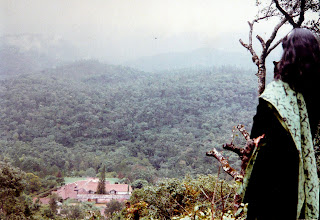Bronze idols of the Aṣṭa-Dikpālakas
Base piece of the flag mast
While on a flying visit to Palakkad, South India last week, I met Ratna Sabhapathy and his sons at their modest shop in the heritage village of Kalpathy. He is a Sthapathy (one specialized in the design and construction of Hindu temples and the related ornamental works) par excellence with a great tradition of serving various temples in Kerala. The metal works of idols, kotimarams, (flag masts) roofing and the ornamental designs of the sanctum are done by them with exquisite mastery in the most traditional way.
I could find at the shop the base piece of a flag mast from the renowned Thiruvalathur temple of Palakkad, famous for its grand architectural beauty and for its sculptural designs. This metal piece was given to the Sthapathy for cleaning and polishing works by the temple authorities.
I could find at the shop the base piece of a flag mast from the renowned Thiruvalathur temple of Palakkad, famous for its grand architectural beauty and for its sculptural designs. This metal piece was given to the Sthapathy for cleaning and polishing works by the temple authorities.
What attracted me to this piece were the presence of the beautiful ancient bronze idols of Aṣṭa-Dikpālakas, the eight guardians who rule the eight cardinal directions to protect the universe according to the Hindu mythology.
These gods are also the guards of the presiding deity of a temple and are seen as balikkallu (sacrificial stones) around the sanctum of the temple. Following are the Aṣṭa-Dikpālakas and the directions attributed to them.
Indra, with Vajrayudha in hand - East
Īśāna , with Trident in hand - Northeast
Soma or Vaisravana with Club in hand - North
Vayu with Ankush and Rope in hands - Northwest
Varuṇa with Rope in hands - West
Nirṛti with Sword in hand -Southwest
Yama with Sword and Shield in hands - South
Agni with Ladle in hand -Southeast

Īśāna , with Trident in hand - Northeast
Soma or Vaisravana with Club in hand - North
Vayu with Ankush and Rope in hands - Northwest
Varuṇa with Rope in hands - West
Nirṛti with Sword in hand -Southwest
Yama with Sword and Shield in hands - South
Agni with Ladle in hand -Southeast

Indra , with Vajrayudha in hand


Īśāna , with Trident in hand Vaisravana with Club in hand


Vayu with Ankush and Rope in hands Varuṇa with Rope in hands
Nirṛti with Sword in hand Yama with Sword and Shield in hands

Agni with Ladle in hand
Photos of these exquisite antique idols taken by me are shown for the enjoyment of the readers. Here, all the deities are in standing postures unlike in the sitting postures I have seen at other temples.
Dubai, 8th October 2008
Dubai, 8th October 2008






Comments
Thank you, AT Sir for the compliments.
Yes, of course! The alignment of the idols will be properly done based on the direction attributed to each Ashta Dikpalaka.
The concept has much grandeur about it because essentially the Ashta Dikpalakas are believed to be the protectors of the universe from different directions. In the Kerala context, it may be noted that the South-east is the Agni kone and hence the kitchens of old tharavads-where the agni will burn for most of the time- compulsorily used to be in the north-east part of the household.Also,north east seems more appropriate for protection from Agni because the south west monsoons with winds from that direction can not play tantrum in the kitchen which is placed in the north-east.
Leave alone the religious beliefs, there could be some scientific basis for all these concepts.